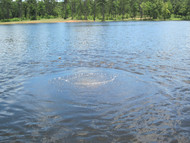Summer vs. Winter Diffuser Placement
Published by Underwater Warehouse on Aug 12th 2021
Typically, air diffusers should be placed in the deepest sections of a pond or lake. This ensures as much water as possible is being turned over and there is good oxygen supply. It is important, however, to think about the placement of your diffuser assemblies as the seasons change, as their placement under water can drastically change the outcome at the surface.

In the summer months, it’s common for diffusers to be placed long distances from shore to make sure they’re placed at the deepest points. If these diffusers are kept in the same spot during winter months, however, they’ll create areas of open water far from shore, posing a potential risk to people and animals. It would be all too easy for someone to fall through thin ice or into open water without an easy way out.
As a general rule of thumb, an air diffuser will keep a 3 ft. diameter area of open water for every 1 ft. of depth. So, for example, in 10 ft. of water, you can expect roughly 30 ft. diameter of open water. Local conditions and a variety of factors can alter this. If you’re concerned about people or animals inadvertently falling into open water, there are two easy recommendations to prevent it.
First, is to simply turn off the diffusers in the winter. This does come with a risk to your fish, however, as preventing an open water area could lead to a winterkill situation. Second, and a method that can be the best of both worlds, is to move the diffuser(s) closer to shore. This achieves two goals. First, it will help maintain your thermal mass in small, shallow ponds by not mixing the deepest, warmest water. Second, the open water area is in contact with the shore meaning anyone or anything that may fall in can simply walk out.

We recommend installing several warning signs next to the pond or lake that has areas of open water.
If you have any questions, contact us at 215-244-4300 or sales@underwaterwarehouse.com.

